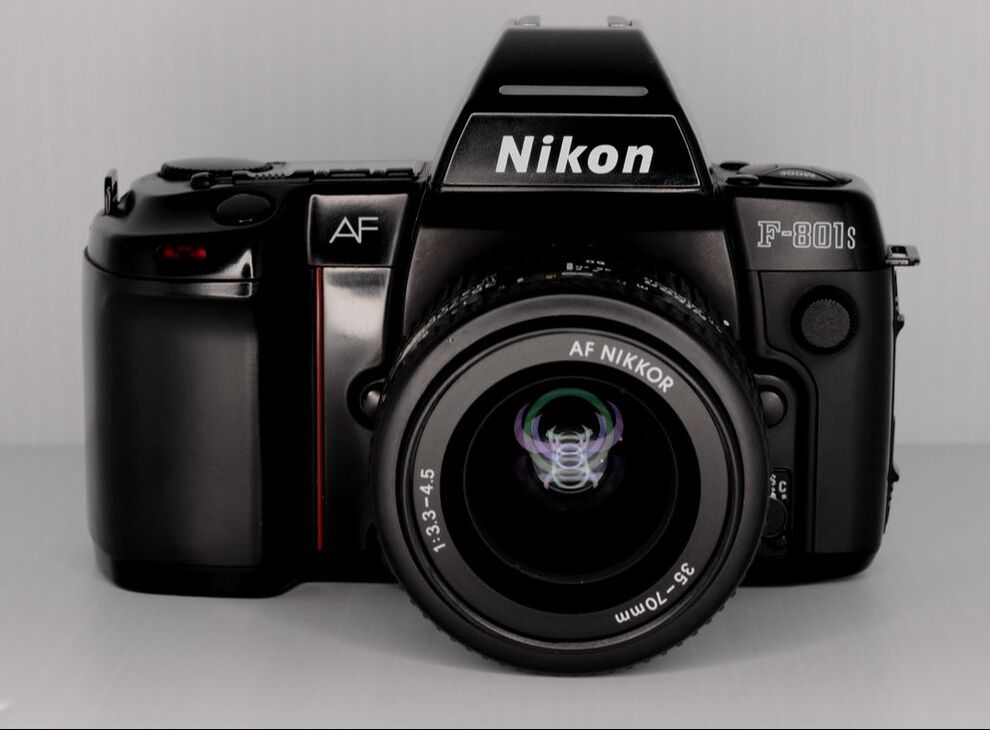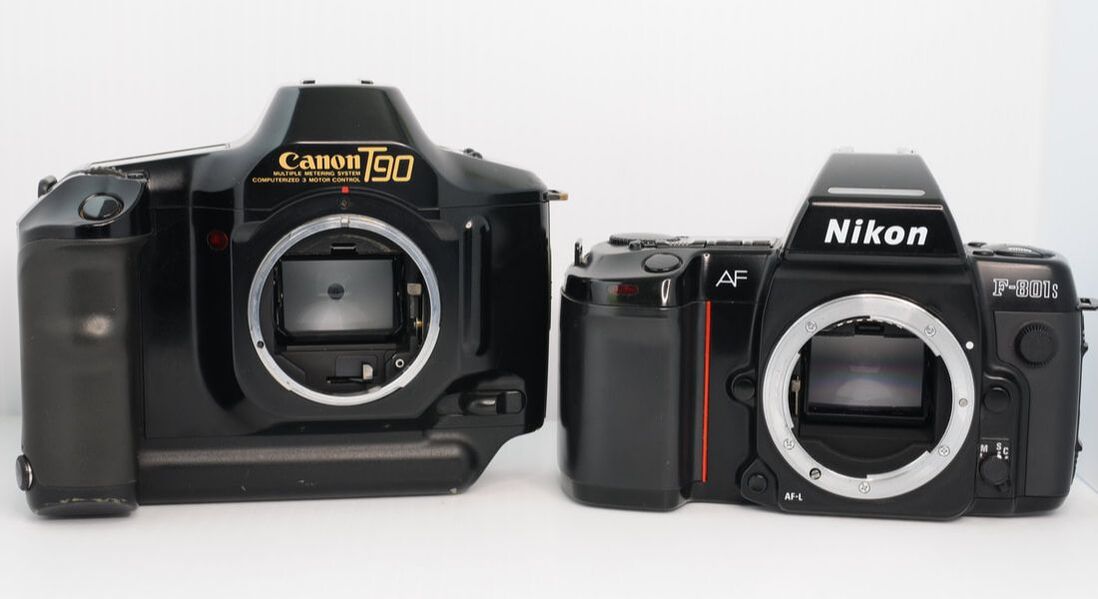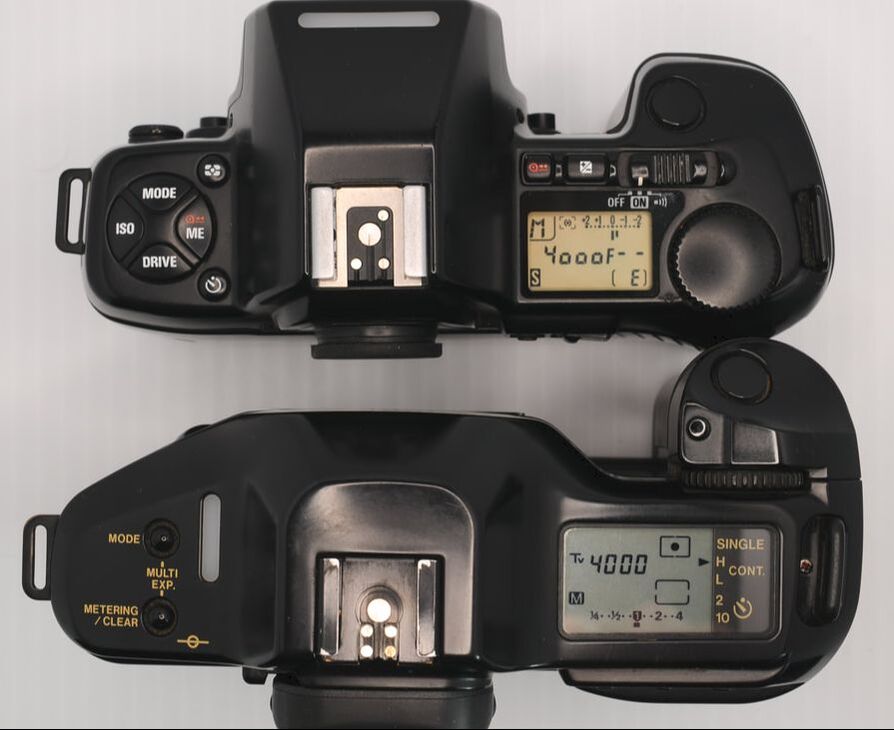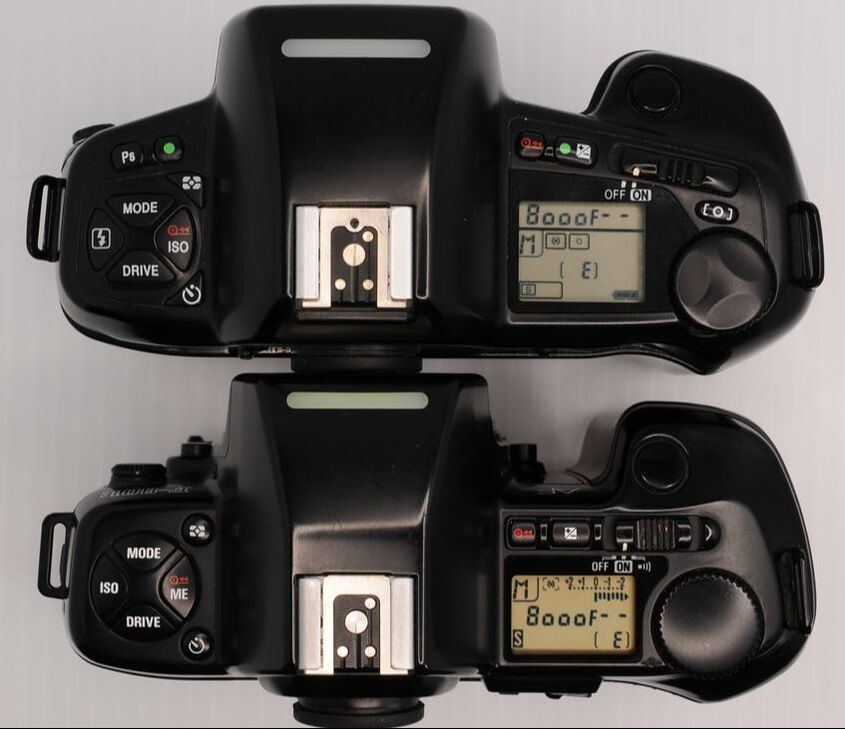|
Updated Mar. 8, 2024 As the purveyor of choice for professional SLRs for over three decades, it shouldn't come as a surprise that Nikon was among the more conservative of manufacturers. After all, most professionals in any field are inclined to stick with the tried-and-true over any newfangled gee-whizzery that comes along. Case in point: the original F lasted in production for 14 years, the whippersnapper F2 for 9, and the last bastion of manual focus pro Nikons, the F3, stuck around for 21 years. Likewise, the enthusiast-targeted FM/FE/FA platform barely changed in layout (a couple of minor control changes from the original FM to FE in 1978, and in the final FM3A model of 2001 being the biggest modifications) in nearly a quarter-century of production. So when Nikon did make major design changes, even in their non-professional models, it was a...big...deal. The summer of 1988 brought such a change, the DNA of which has managed to leapfrog from the venerable F-mount (in both film and digital forms) to the latest Z-mount mirrorless models. Worst of all for Nikonistas, it originally came from C...C...C...Canon (aaauuuggghhh!!!). Nikon in the Year '88 1988 was always destined to be a big year for Nikon. True to their every-other-Olympiad introduction schedule for a new pro SLR, Nikon had the Seoul Summer Games circled in red (what else?) on their calendars, and anticipation for the F4 was palpable. It was not just going to be the latest F-body to drop on the competition, but it was also widely rumored that it was going to be the first professional Nikon SLR to sport auto focus (AF). The F4 would meet all expectations and then some, but in reality it would prove to be more of a one-off MF/AF hybrid than the herald of a new Nikon era. That task would be left to the prosumer Nikon body that was introduced five months earlier in April 1988. Ironically, the F-801 (N8008 in the USA), while quickly overshadowed by the glow of the F4's resplendent entrance, would prove to be far more influential in the design of all future Nikon SLRs (including the pro bodies). The F4 may have been the figurehead, but the F-801 had the control...and that's what it was all about - control - or more specifically, control layout. SLR controls had originally developed in an era of complete analog design. Every operation was mechanically-actuated and so the user interfaces of these cameras were directly coupled by physical means to the various functional bits (e.g. film winding/rewinding, shutters, lens mounts, aperture controls) by a variety of dials, gears and levers. And even when the first models with electronic components began to appear en masse in the early 1970s, such electronics did not replace mechanical systems, but only served to trigger those analog assemblies. But with the advent of microprocessors in the mid-to-late-'70s (a la the Canon AE-1 and its gaggle of imitators), it was only a matter of time before wholesale replacement of many mechanical systems by electronics became common. Many film enthusiasts (then and now ;-)) would decry such changes, but there would be no going back for the manufacturers: electronics were simpler and, therefore, cheaper to produce, and money always wins. But it would take another 10 years before the ultimate expression of modern SLR controls would arrive in its seminal form, courtesy of (again) C...C...Canon. (Notice that I was able to regain guttural control one stutter sooner this time :-)) Leave it to Canon, Nikon's longtime nemesis, to come up with a completely new control paradigm that would become a necessity rather than just an alternative for the increasingly feature-laden SLRs offered over the last decade-and-a-half of the 20th century. Now, there were plenty of push-button electronic SLRs that came along between the AE-1 and the trendsetting T90 (1986). But it was the way that the T90 married push buttons with an electronic multi-purpose input dial and LCD that would change SLRs forever. Irony would strike yet again as the T90 would be on the bleeding edge of mid-'80s SLR technology in all areas save one: AF. Of the four major technological leaps in SLR design that typified the decade (internal motorized film handling, multi-spot or multi-segment metering, and button + dial + LCD controls being the other three), the lack of AF doomed the T90 in the sales department. But its advanced control design and internal layout did not go unnoticed by its competitors and Nikon, in particular, when it came to the F-801. The F-801: A T90 in Nikon Livery? So just how much "inspiration" did Nikon take from the Canon T90? Well, let's leave the control layout concept for last, as there are plenty of other places to start:
Okay, now that we have those smaller details out of the way, let's get down to the major feature that Nikon (and eventually, every other AF SLR manufacturer) lifted from the T90: the button + Electronic Input Dial (Canon's term) + LCD configuration. The reason Canon (led by the T90's outside consultant/designer Luigi Colani) developed the electronic dial interface was the rapidly ballooning feature sets of advanced SLRs. Consider, for a moment, the challenge of finding the real estate for physical dials or levers capable of not only setting but legibly displaying:
This all added up to 121 different possible settings spread over 7 individual controls, which would have made for a hot, bloated mess with the traditional SLR interface or an insane amount of button pressing using an interface like Canon's T70 sported. But, by using an electronic multipurpose dial that travelled infinitely in both directions, it was now possible to assign these various functions to much smaller individual buttons that could be pressed singly or in pairs and then spinning the Electronic Input Dial to select the desired setting. Nikon, of course, had their own ideas about how to implement their version of this new approach to SLR control, which we will dig into next. But, for a minute, let's just stop and think about how massive this change was for them. Aside from the mechanical Nikkor/Nikomats, every Nikon SLR since 1959 had sported the same basic control layout as the Nikon F. Nearly three decades with no major changes. And then to adopt the same premise developed by their fiercest rival? Quite a bold move for a company commonly considered to be as staid and conservative as they came. The F-801 would become just the second SLR of any brand to adopt this new control philosophy. But it would be far from the last. The F-801's Implementation of Button + Dial + LCD Controls Obviously, Nikon wasn't going to just straight-out up and copy Canon. There were patents and all that sort of thing to deal with. But it went deeper than just avoiding patent infringements. They definitely had their own philosophy about how this new control concept should affect the photographer. So let's take a closer look at how the F-801 (and all subsequent prosumer Nikons) differed from the T90 (and all subsequent prosumer Canons) in how the user interacted with the controls. Both cameras featured a single dial (Electronic Input Dial in trademarked Canonspeak and Command Input Control Dial in Nikonese). On the T90, this dial was oriented vertically directly behind the shutter release to be operated by the right index finger. Nikon disliked this arrangement as it required the user to lift their finger off of the shutter release to make any adjustments and then return it to that position (or use their middle finger for shutter release leaving the index finger free for scrolling the dial). Their solution was to orient the dial horizontally and to the rear of the top plate for operation via the right thumb of the user. This would keep the index finger on the shutter release ready to capture that "decisive" moment ;-). Both companies would add more dials in the years to come (Sub Command Dials mounted horizontally under and protruding in front of the shutter release for the Nikons, and vertical Quick Control Dials on the film backs of the Canons), but the paradigms were set with the T90 and F-801. And you can still see them in both manufacturer's latest DSLR (and mirrorless, for that matter) models :-). A Truly New Nikon As noted earlier, while the F4 outshone the F-801 upon its public availability in December 1988, the F-801 would prove to be far more impactful when it came to the development of future generations of Nikon SLRs. And Nikon played the introduction of both models on dealer's shelves rather well, gapping them by about six months, allowing the F-801 grab a few headlines of its own before being eclipsed in the press by the F4. The F-801/N8008 was the first SLR to offer a top shutter speed of 1/8000 sec. (likely the reason for the prominently-featured "8" in both model designations :-)), with the F4 soon following, giving Nikon a brace of the fastest SLRs on the market. Other notable (albeit, in some cases, short-lived) industry- or Nikon-firsts included:
Descent Into Obscurity AF SLR development proceeded at a breakneck pace into the mid-'90s as both Canon and Nikon caught up to first-mover Minolta and soon were forming a duopoly of AF SLR domination. The F-801 would be in production for less than three years (selling around 600,000 units or roughly three for every F4 sold during that time) before being updated into the F-801s in March 1991. The F-801s would then be supplanted as the top enthusiast Nikon AF model by the F90/N90 only a year-and-a-half later. It would remain in the sales lineup until March 1995 (with sales in the 360,000-range), but was again overshadowed by its progeny (in identical fashion, the F90/N90 was updated into X/s versions in 1994 with AF improvements again being the major objective). Popular Photography never managed to put either version of the F-801 through its famous lab test as they simply lost track of them with other newer models (such as the F4 and N6006/F-601) just pipping them to the post when they were about to get around to it. So, even in its heyday, the F-801 flew somewhat under the radar as far as notoriety was concerned. That didn't stop it from becoming a beloved body for many an enthusiast or pro, in other words, a workhorse (if that isn't the ethos of a Nikon SLR, I don't know what is :-)). You could buy one for a third of the cost of an F4, it weighed a third less (and when compared to the F4s ("s" designated the 6 AA MB-21 grip, in this case) weight was almost halved), and did almost everything the F4 could (the most glaring exceptions being Focus Tracking, Spot Metering, and that 15% more powerful AF motor, all of which would be incorporated into the F-801s). There are a few other areas where the F-801 could leave certain potential users wanting for more: mirror lock-up (MLU), a PC sync port for studio lighting, and a 100%-coverage viewfinder being three of them. Oh, and it couldn't Matrix meter with non-CPU (AI & AI-s) lenses like the F4 (psst, not really a big deal, or even a small one as early Matrix metering conferred about a 10% improvement over centerweighted when it came to getting exposure correct in tricky lighting situations; it was not infallible). For what it's worth, I would take the 75/25 centerweighting of the F-801 over the 60/40 ratio of the F4 any day :-). The dawn of the digital era only served to hasten the demise of the F-801(s) into the netherworld of SLRs. And there it remains today, still in the shadows...available for a fifth of the cost of an FE2 (which, along with the FA, it directly replaced in Nikon's SLR lineup). Which raises the question: WHY? Why is such a capable, groundbreaking camera still on the fringes of 35mm film enthusiasts' consciousness? It's actually not that complicated. The F-801 simply does not look nor feel the part of a "classic" SLR (unlike the FA, which Nikon went to great lengths to style conventionally while packing in as much technical sophistication as they could back in 1983). No milled shutter speed dial nestled next to the prism housing. No film advance lever to be caressed by a right thumb. No manual rewind crank to be tenderly twisted till the film is tucked safely inside the cartridge. No match-needle gently floating in the viewfinder. No lovely leatherette to nuzzle your fingertips. No cool-to-the-touch brass or aluminum to soothe your skin. Instead, you've got pernicious polycarbonate, dastardly digital displays, and those woeful, whining motors to contend with. The 35mm film snob's worst nightmare writ large ;-). In a rich twist, you could say it suffers from the same perception as its longtime arch rivals from Canon: capable of photographic near-perfection with a chaser of "meh" and two shots of "blah" for the purist. The consequence: zero street cred among hipsters and other nostalgists. But that reputation of reprobation also ranks it among the best values in film SLRs today. So should you bother looking at one? Is An F-801(s) in Your Future? In my experience, there are two ends of the scale for photographer types: 1) those looking for the shortest distance between visualization and execution of an image and who could thus care less about what equipment they use to reach that goal as long as the equipment facilitates the goal, and 2) those who prefer their equipment and the way it feels in hand and to eye to contribute measurably to the process. I find myself somewhere between the two, often just depending on the day and the mood that I am in. But if you generally lean towards the latter notion, the F-801 likely will prove disappointing should you decide to try it. If you are closer to the former, it might prove a compelling choice. Many times you will hear Type 1 photogs say that they prefer cameras that "just get out of my way". The F-801 is one such SLR. Although primarily intended as an AF-centric body, it does a very good job as a manual focus SLR, too. Here are a few key attributes:
Things to look out for include:
Wrap-Up I found my personal F-801s in an online classified this year for $35 USD. The original owner supposed he had put maybe 20 rolls through it. The alkaline batteries in the camera had leaked (but not badly, fortunately) when I opened it up and popped four lithiums in to test it. It fired right up. As soon as I got it home, the battery compartment and holder received the vinegar and Q-tip treatment. I'm now left holding a camera with approximately 99% of its rated shutter cycles remaining (50,000, which was conservative as per the Nikon Way back then :-)), and a squeaky-clean viewfinder. The last new F-801s bodies at B&H Photo sold for $1,050 USD (inflation-adjusted to 2021) in March 1995. 97% depreciation...I'll have to live with that...I guess...if I have to ;-). Even at the more common going rate of $100 USD for excellent copies, the F-801 remains one of the best SLR bargains going today, if outright photographic capability is high on your priority list. I'll take the weight savings over an F4 any day and it works with my motley collection of AI-converted to AF-D Nikkors perfectly. Is it the body I take out every time? Nope. I love my manual winding, manual focus bodies when the situation calls for it. And if I want the ultimate in single-sensor Nikon AF performance, the F90X comes along. But when I want a camera to just get out of my way and let me lose myself in the fun of photography, the F-801s is a lean, mean, film-slingin' machine. While it is no Nikon F in form nor reputation, it has more than pulled its weight in perpetuating the long-standing Nikon trait of solid, workmanlike performance. And that still makes it a Nikon to me; even if it's commonly considered to be the photographic equivalent of an '80s cover band. Well, a cover can be alright in its own right, and sometimes it can give the 1959 original a run for its money ;-). References: Nikon N8008 Brochure @ www.pacificrimcamera.com Canon T90 Brochure @ www.pacificrimcamera.com Canon EOS 620 Brochure @ www.pacificrimcamera.com Nikon N8008 User Manual @ www.butkus.org/chinon/nikon.htm Nikon N8008s User Manual @ www.butkus.org/chinon/nikon.htm Debut of Nikon F4 @ https://imaging.nikon.com/history/chronicle/history-f4/index. CAMERA; The Future Is Here - Andy Grundberg, NYT, Apr. 17, 1988 Popular Photography magazine - June 1988 p. 28; May 1991 p. 12; Dec. 1996 p. 252 Popular Photography Test Report: Nikon F4s - June 1989 p. 48 Minolta 7000i User Manual
8 Comments
Gil Aegerter
3/2/2022 09:58:37 am
I've had a couple of these and they seemed fine if you don't mind the whole noisy shutter/wind thing. But I still prefer a manual focus F2 or F3.
Reply
C.J. Odenbach
3/2/2022 10:39:06 am
Nice to hear from you, Gil. And I wholeheartedly agree that, given my druthers, I would also pick up an F2 or F3 for most situations that I encounter, especially for MF and the lack of noise. It's nice to have choices :-).
Reply
Bob G.
3/22/2022 09:37:20 am
Thank you for your excellent article. I found your comments lively, nteresting and informative. The 90x seems to be showing up more and more on the web as a better choice before the jump in $$$ to the F100. Still, the 801s may still be the best value these days. I have one and found your review accurate.
Reply
C.J. Odenbach
3/22/2022 05:01:17 pm
Glad to hear you enjoyed the article, Bob. It's good to hear from others that have experience with the camera and get their perspective on it. I appreciate the feedback. Take care.
Reply
Tom
9/20/2022 11:13:23 pm
Just got back to this excellent article after picking up a couple of these cameras for about $30 U.S. each, *inclusive* of shipping. Each in excellent condition. I mean, nary a scratch or a scuff or an LCD bleed. These things have to be the greatest deal going in analog photography.
Reply
C.J. Odenbach
9/24/2022 10:09:03 am
Thanks for the great comment, Tom. And congratulations on snagging a couple at those prices :-). I agree that these are the price-to-performance champion of vintage SLRs and its not particularly close.
Reply
C.J. Odenbach
4/10/2024 10:15:21 pm
I think that sums up the feelings of most who started out with the manual focus F-series, Matt. The F-801/N8008 was the biggest change in the interface of Nikon SLRs in 30 years. and even though polycarbonate has proven its toughness and resilience over decades now, it still cannot impart the "feel" of the older metal bodies in the hand.
Reply
Your comment will be posted after it is approved.
Leave a Reply. |
C.J. OdenbachSuffers from a quarter-century and counting film and manual focus SLR addiction. Has recently expanded into 1980's AF point and shoots, and (gack!) '90s SLRs. He even mixes in some digital. Definitely a sick man. Categories
All
Archives
June 2024
|




 RSS Feed
RSS Feed